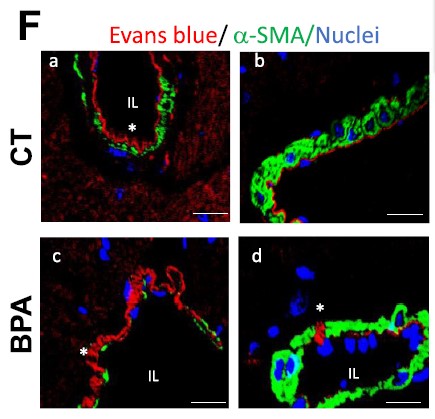
A new article has been recently published about Cardiac hypertrophy research in the Scientific Reports Jorunal by NatureResarch, counting with the expertise of NANBIOSIS unit 17 Confocal Microscopy Service form CIBER-BBN and University of Alcalá de Henares.
Cardiac hypertrophy is the abnormal enlargement, or thickening, of the heart muscle, resulting from increases in cardiomyocyte size and changes in other heart muscle components, such as extracellular matrix. This article relates more especifically with the link between long term exposure to xenoestrogen Bisphenol-A and adverse cardiovascular effects and the role of necroptosis in cardiac response to BPA had not yet been explored.
NANBIOSIS U17, Confocal microscopy Unit is mentioned in the Materials and Methods section: Slides containing tissue sections were incubated with the primary antibodies overnight 4 °C. After washing with PBS, the slides were incubated with FITC, Alexa-488, or Alexa-647-conjugated secondary antibodies for 1 hour at room temperature. Nuclei were stained with Hoechst. Images were taken for data quantification using a Leica TCS SP5 confocal microscope (UAH-NANBIOSIS-CIBER-BNN). At least five different fields per condition were obtained.
In the picture, F) Representative confocal images from heart sections of CT and 8 weeks treated BPA mice after injection with Evans blue (red fluorescence) followed by immunostaining for α-SMA (green). Nuclei were labeled with Hoechst in blue (n = 4 mice per condition). (a and b) CT hearts sections obtained at different magnifications showed no signs of EB extravasation. (c) and (d) are different sections of coronary arteries of BPA hearts with extravasation areas. Scale bar = 25 μm (a and c) and 50μm (b and d). IL = intraluminal area and (*) marks areas of EB extravasation.
Article of refrence:
Reventun, P., Sanchez-Esteban, S., Cook, A. et al. Bisphenol A induces coronary endothelial cell necroptosis by activating RIP3/CamKII dependent pathway. Sci Rep 10, 4190 (2020). https://doi.org/10.1038/s41598-020-61014-1








